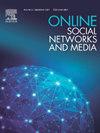Community detection in Multimedia Social Networks using an attributed graph model
Q1 Social Sciences
引用次数: 0
Abstract
In this paper, we design a novel data model for a Multimedia Social Network, that has been modeled as an attribute graph for integrating semantic analysis of multimedia content published by users. It combines features inferred from object detection, image classification, and hashtag analysis in a unified model to characterize a user from different points of view. On top of this model, community detection algorithms have been applied to unveil users’ communities. Hence, we design a framework integrating multimedia features with different community detection approaches (topological, deep learning, representation learning, and game theory-based) to improve detection effectiveness. The proposed framework has been evaluated on a real-world dataset, composed of 4.5 million profiles publishing more than 42 million posts and 1.2 million images, to investigate the impact of different features on both graph-building and community detection tasks. The main findings of the proposed analysis show how combining different sets of features inferred from multimedia content allows to achieve the highest modularity score w.r.t. other configurations although it requires a higher running time for building the underlined network. Specifically, representation and game theory-based algorithms achieve the highest results in terms of Modularity measure by exploiting the semantic and contextual information integrated into the proposed model.
基于属性图模型的多媒体社交网络社区检测
本文设计了一种新的多媒体社交网络数据模型,并将其建模为一个属性图,用于集成用户发布的多媒体内容的语义分析。它将从物体检测、图像分类和标签分析中推断出的特征结合在一个统一的模型中,从不同的角度来描述用户。在这个模型之上,社区检测算法被应用于揭示用户的社区。因此,我们设计了一个将多媒体功能与不同的社区检测方法(拓扑、深度学习、表示学习和基于博弈论)集成的框架,以提高检测效率。提议的框架已经在一个真实世界的数据集上进行了评估,该数据集由450万个个人资料组成,发布了超过4200万个帖子和120万张图片,以调查不同特征对图构建和社区检测任务的影响。所建议的分析的主要发现表明,结合从多媒体内容推断出的不同功能集如何能够实现比其他配置更高的模块化得分,尽管构建下划线网络需要更高的运行时间。具体来说,基于表示和博弈论的算法通过利用集成到提议模型中的语义和上下文信息,在模块化度量方面取得了最高的结果。
本文章由计算机程序翻译,如有差异,请以英文原文为准。
求助全文
约1分钟内获得全文
求助全文
来源期刊

Online Social Networks and Media
Social Sciences-Communication
CiteScore
10.60
自引率
0.00%
发文量
32
审稿时长
44 days
 求助内容:
求助内容: 应助结果提醒方式:
应助结果提醒方式:


